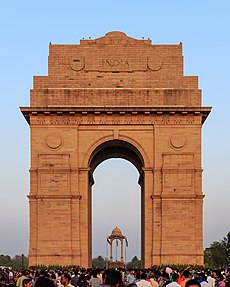National Symbols of India :
| Title | Symbol | Image | Notes |
| National Flag | The Indian Tricolor or the National Flag of India has been designed by Pingali Venkayya.s |  |
The National Flag of India has three colors placed horizontally. On the top of the flag is Saffron color, in the middle, there is a white color and at the bottom, green color can be seen. |
| National Emblem | Asoka’s Lion Capital or the National Emblem of India |  |
India’s National Emblem was adopted on the day when the country became republic that is on 26th day of January, 1950. India’s motto written in the Devangari Script is “Satyamev Jayate” which is encompassed by this Emblem. The meaning of this motto is “Truth Alone Triumphs”. |
| National Monument | India Gate |  |
The India Gate, (originally called the All India War Memorial), is a war memorial located astride the Rajpath, on the eastern edge of the ‘ceremonial axis’ of New Delhi, India, formerly called Kingsway
The India Gate situated in Delhi,was part of the work of the Imperial War Graves Commission (I.W.G.C), which came into existence in December 1917 for building war graves and memorials to soldiers killed in the First World War |
| National Calendar | Indian National Calendar(Saka Calendar) | In the year 1957, the Calendar Reform Committee introduced Indian National Calendar or Saka Calendar as inherent part of Nautical and Ephemeris Almanac containing huge astronomical data. There are many formulae and timings in the calendar that are used to ascertain Hindu religions. The Hindu Calendar is based on these timings and formulae but at the same time, local variations can also be seen in older sources such as Surya Siddhanta.The use of this calendar started in 1879, Chaitra 1, Saka Calendar on 22nd March, 1957. | |
| National Anthem | “Jana Gana Mana”by Rabindranath Tagore | The Constituent Assembly of India adopted “Jana Gana Mana” officially on 24th January, 1950 as the National Anthem of the country. | |
| National Song | Vande Mataram by Bankim Chandra Chatterjee | In the Indian National Congress’s Session, “Vande Matram” was officially sung for the first time in the year 1896 session. | |
| National Flower | Indian Lotus(Nelumbo Nucifera) |  |
Occupying a unique position in the methodology and art belonging to the ancient era, the Lotus Flower has been adopted as Indian culture’s auspicious symbol. |
| National Fruit | Mangifera Indica(Mango) |  |
More than 100 varieties of mangoes are found in India. They are available in a variety of shapes, sizes and colors. Since a long time, mangoes have been grown in India. The praise of this fruit has also been sung by the famous poet, Kalidasa. Its taste was also savored by Alexander the Great just like Hieun Tsang, a Chinese pilgrim. In Darbhanga located in Bihar, about 100, 000 trees of mango were planted by Akbar at Lakhi Bagh. |
| National River | Ganga |  |
India’s most sacred and longest river of the country, the Holy Ganges is the most populated river basin all over the world. This river is considered as very sacred and is revered by Hindus. |
| National Tree | Indian Banyan or Indian Fig Tree(Ficus Bengalensis) |  |
In order to grow new trees and spread over a large area, the Indian Banyan tree’s branches root themselves into the soil. This tree reflects the longevity and characteristics and as such this tree is considered to be immortal. Today, it has become a vital part of Indian legends and myths. |
| National Animal | Royal Bengal Tiger(Panthera Tigris) |  |
All over the country, the Bengal Tiger can be seen except in North west part of the country. |
| National Aquatic Animal | Gangetic Dolphin(Platanista Gangetica) |  |
India’s Holy river Ganga’s purity is represented by the Gangetic Dolphin as this species can only survive in fresh and pure water. |
| National Bird | Indian Peacock(Pavo Cristatus) |  |
India’s National Bird is Peacock and is found in jungles. |
| National Heritage Animal | Elephant |  |
In order to increase the population of Asiatic elephant, the largest mammal species on land, the ministry of environment has declared it the National Heritage Animal. Around 60% of live in India |
| National Currency Symbol | Indian Rupee |  |
The current Indian Rupee’s symbol reflects the international identity of the country used for transactions of money and depicting economic strength. The sign is an Indian ethics allegory of the Indian Rupee. A unique blend of Devangari script “Ra” and “R”, the Roman Capital with two horizontal parallel lines that runs from the top of the National Flag and a sign of equality. The Indian Government adopted this Indian Rupee sign on 15th of July, 2010.This Indian Rupee symbol was created and designed by an Indian Institute of Technology graduate from Bombay, Uday Kumar. The Finance Ministry selected this design created by this designing student from among thousands of entries. There was an open competition for the residents of the country. Using myriad computer applications and digital technology, this new identity of the Indian rupee was created. |
Latest Govt Job & Exam Updates:
